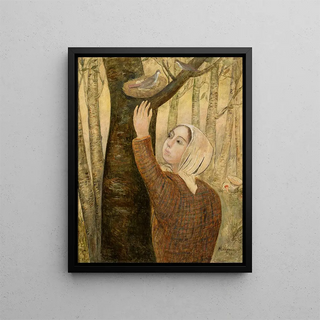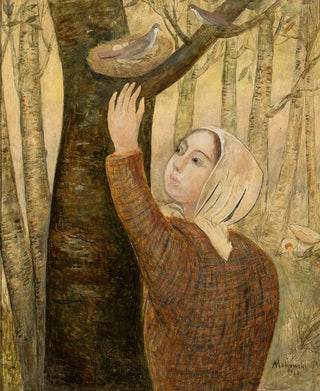Art print | Self-portrait with palette - Tadeusz Makowski


View from behind

Frame (optional)
Art print Self-portrait with a palette - Tadeusz Makowski – Captivating introduction
In the vast panorama of 20th-century art, the work of Tadeusz Makowski stands out for its ability to capture the very essence of the artist through a prism that is both intimate and universal. "Self-portrait with a palette" is part of this quest for artistic identity, revealing the nuances of a creator in deep reflection on his role in the art world. This piece does not merely depict a face; it evokes a story, a personal and artistic journey, where each brushstroke seems to resonate with echoes of his inspirations and inner struggles.
Style and uniqueness of the work
The originality of "Self-portrait with a palette" lies in its bold treatment of colors and shapes. Makowski, a true master of tone, plays with a vibrant palette that transcends simple representation to immerse the viewer in an almost dreamlike atmosphere. The blurred contours and bright hues create a dialogue between the artist and his work, inviting each to question what lies behind this colorful facade. The face, both familiar and enigmatic, appears to express a multitude of emotions, oscillating between melancholy and determination. This portrait does not merely represent an individual but becomes a symbol of the quest for identity and the complexity of the human soul.
The artist and his influence
Tadeusz Makowski, born in Poland and mainly active in France, is an artist whose journey is marked by a wealth of experiences and a diversity of influences. His work is often associated with the expressionist movement, but it also incorporates elements of cubism and surrealism, demonstrating an eclectic and innovative approach. Makowski drew from his cultural heritage while allowing himself to be influenced by the artistic currents of his time. His commitment to portraying the artist as a vulnerable creator paved the way for new reflections on subjectivity in art. Through "Self-portrait with a palette," he offers a mirror not only to himself but also to all those who see themselves in the struggle for authenticity and the complexity of the human condition.

Matte finish

View from behind

Frame (optional)
Art print Self-portrait with a palette - Tadeusz Makowski – Captivating introduction
In the vast panorama of 20th-century art, the work of Tadeusz Makowski stands out for its ability to capture the very essence of the artist through a prism that is both intimate and universal. "Self-portrait with a palette" is part of this quest for artistic identity, revealing the nuances of a creator in deep reflection on his role in the art world. This piece does not merely depict a face; it evokes a story, a personal and artistic journey, where each brushstroke seems to resonate with echoes of his inspirations and inner struggles.
Style and uniqueness of the work
The originality of "Self-portrait with a palette" lies in its bold treatment of colors and shapes. Makowski, a true master of tone, plays with a vibrant palette that transcends simple representation to immerse the viewer in an almost dreamlike atmosphere. The blurred contours and bright hues create a dialogue between the artist and his work, inviting each to question what lies behind this colorful facade. The face, both familiar and enigmatic, appears to express a multitude of emotions, oscillating between melancholy and determination. This portrait does not merely represent an individual but becomes a symbol of the quest for identity and the complexity of the human soul.
The artist and his influence
Tadeusz Makowski, born in Poland and mainly active in France, is an artist whose journey is marked by a wealth of experiences and a diversity of influences. His work is often associated with the expressionist movement, but it also incorporates elements of cubism and surrealism, demonstrating an eclectic and innovative approach. Makowski drew from his cultural heritage while allowing himself to be influenced by the artistic currents of his time. His commitment to portraying the artist as a vulnerable creator paved the way for new reflections on subjectivity in art. Through "Self-portrait with a palette," he offers a mirror not only to himself but also to all those who see themselves in the struggle for authenticity and the complexity of the human condition.






